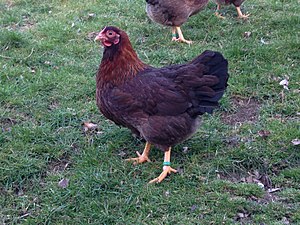Dwarf Dresdner
| Dwarf Dresdner | |
|---|---|
|
Hen in rust-partridge color Rooster, rust-partridge-colored |
|
| BDRG - Standard No. | |
| origin | Dresden |
| year | Recognized in the FRG in 1967 |
| colour | golden brown, rust-red, black, white, sparred, brown-blue drawn |
| Weight | Tap 1.0 kg Hen 0.9 kg |
| Laying performance | average of 182 eggs, top performance: 237 eggs |
| Eggshell color | brown |
| Egg weight | 40 g |
| List of breeds of bantam | |
Zwerg-Dresdner are a breed of bantam that was bred by Siegmar Zumpe from existing breeds with a focus on performance.
Origin of the bantam breed
The development and breeding of this breed took place from 1951 by Siegmar Zumpe in Wilschdorf , a district of the Saxon state capital Dresden . Siegmar Zumpe is the son of Alfred Zumpe, the breeder of the great Dresden breed . The first animals were combined from large breed hens that had remained small, Antwerp bearded dwarfs and light-colored dwarf Wyandottes . In what was then West Germany , golden-brown dwarf New Hampshire and yellow dwarf Wyandot were used for type consolidation, which in 1967 led to the recognition of the West German standard.
Performance and characteristics of the bivalve
The willingness to lay falls only slightly during the winter months. In general, this breed is particularly well adapted to cold weather, as the breed-specific rose comb is not as prone to frostbite as a single comb, for example .
Dwarf Dresdeners have light-colored, non-fibrous meat, which covers the second characteristic of a bivalve , namely the meat product.
In terms of type, they appear a bit rough. The Zwerg-Dresdner is a temperamental and hardy bantam.
By nature they are extremely trusting towards humans, whereas roosters often want to defend their territory to a great extent. Therefore, minor ranking battles, which usually end bloodlessly, cannot be avoided. This behavior can also be observed in the hens, which also tend to feed envy, a characteristic of a good egg layer.
Standard and form of the dwarf Dresdner
In a clear distinction to the otherwise very similar dwarf New Hampshire dwarf Dresdeners have a longer body. They have a wide saddle area corresponding to their shoulder width. The topline runs horizontally and rises without angular course into the tail, which is carried at an obtuse angle. The cock's sickles shouldn't be too long. Both the chest and stomach area appear full. The dwarf Dresdner has a medium high stance, the thighs stand out less, the legs are medium high. The hen's tail should be broad and carried open. The rose comb is set wide at the front. Its thorn follows the neck. The wattles should not be too long to match. The ear lobes are red, the eyes are orange to red.
With the Dresdner there is also a breed of chicken, which is looked after by the same special association as the dwarf Dresdner. The dwarf Dresdeners are numerically more common than the large breed.

